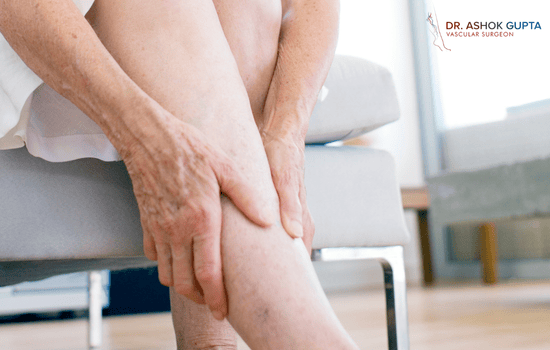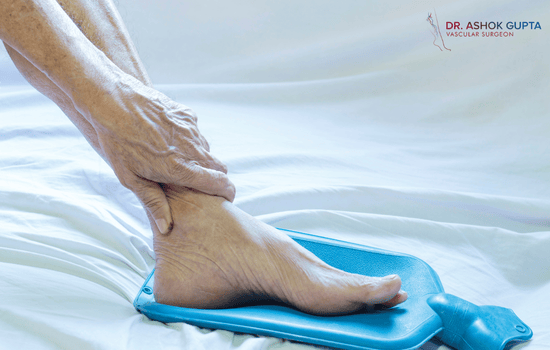Poor Circulation in the legs: Symptoms, Causes, Treatment

Do your legs often feel heavy, tired, or even painful?
Do you experience numbness, tingling, or a cold sensation in your feet?
These are potential signs of poor circulation in the legs, a common issue that can have a major effect on how you feel and live. This blog will illuminate the symptoms, causes, and available treatments.
What are the symptoms of poor blood circulation in the legs?
Poor circulation occurs when blood flow to your legs is reduced, preventing them from receiving the needed oxygen and nutrients. This can manifest in various ways, and recognising these symptoms of poor blood circulation in the legs is the first step towards seeking help.
Common signs include pins-and-needles sensation, cramping or pain while walking, and swelling or discoloration in the lower legs. However, you must seek immediate consultation if you notice warning signs.

10 warning signs of poor blood circulation in the legs.
- Cold Feet or Toes
- Numbness or Tingling Sensation
- Swelling in the Legs or Feet
- Leg Cramps (especially at night)
- Discoloration (bluish or pale skin)
- Shiny Skin or Hair Loss on Legs
- Slow-Healing Sores or Ulcers
- Varicose Veins
- Weak or Absent Pulses in Feet
- Pain While Walking (Claudication)
What causes poor circulation in the legs?
Several underlying conditions can lead to poor circulation in the legs. A good understanding of these causes is necessary for successful treatment. Some of the common culprits include:
- Peripheral artery disease (PAD): In most cases, this problem stems from the leg arteries becoming narrow because of plaque buildup, which is termed atherosclerosis.
- Diabetes: Poor circulation can occur when high blood sugar damages blood vessels over an extended period.
- Blood clots: These can block blood flow in veins or arteries.
- Varicose veins: While primarily a venous issue, severe varicose veins can sometimes contribute to circulatory problems.
- Obesity: Carrying extra weight can strain your circulatory system.
- Smoking: Nicotine damages blood vessels and impairs blood flow.
- Raynaud’s phenomenon: If you have this condition, the blood vessels in your extremities tend to narrow when you’re feeling cold or under stress.
The most suitable treatment for poor circulation in the legs depends heavily on identifying what’s causing it.
Poor circulation in legs treatment: What are your options?
The good news is that there are various ways to manage and improve poor circulation in legs treatment.
The chosen treatment strategy will be determined by what’s causing the issue and how severe it is in your situation. Some common treatment strategies include:
1- Lifestyle modifications: This often forms the cornerstone of treatment and includes:
- Regular exercise: Activities like walking can improve blood flow.
- Quitting smoking: This is vital for vascular health.
- Weight management: Losing excess weight can ease pressure on your circulatory system.
- Maintaining a healthy diet: To help prevent more plaque from building up, it’s beneficial to have a balanced diet with limited saturated fats.
2- Medications: Your doctor may prescribe medicine for blood circulation in legs, such as:
- Antiplatelet drugs (e.g., aspirin, clopidogrel) to prevent blood clots.
- Medications to lower cholesterol and blood pressure.
- For better blood flow and relief from claudication symptoms, medications like cilostazol or pentoxifylline may be recommended.
3- Minimally invasive procedures: In more serious instances of PAD, angioplasty (using a balloon to widen constricted arteries) and stenting (inserting a small mesh tube to maintain artery openness) are potential recommendations.
4- Compression therapy: Compression stockings can aid in better blood flow in the legs, particularly if you have venous insufficiency.
Read More About: Compression Stockings For Varicose Veins
How to relieve leg pain from poor circulation?
If you’re experiencing leg pain due to poor circulation, there are steps you can take to find relief:
- Rest: Elevating your legs when resting can help improve blood flow.
- Gentle exercise: Light walking can sometimes alleviate pain during rest periods.
- Avoid prolonged standing or sitting: Make sure you get up and move periodically.
- Keep your legs warm: Cold can worsen symptoms.
- Follow your doctor’s treatment plan: This is the most crucial step in long-term pain management.
Warning signs of poor blood circulation in your system often overlap with the leg-specific symptoms but can also include fatigue, chest pain, and shortness of breath, indicating more widespread circulatory issues.
It’s vital to know the warning signs of poor circulation in your system and to get medical help if you experience any. If you’re concerned about your leg health, take the next step towards better circulation.
With over 30 years of experience, Dr Ashok Gupta, at his Dubai clinic, offers expert diagnosis and advanced, minimally invasive treatments.
Book your consultation today for personalised care and a path to more active living.
FAQ
Fixing poor circulation involves lifestyle changes (exercise, diet, quitting smoking), medications, and sometimes minimally invasive procedures, depending on the cause and severity.
Symptoms include pain/cramping, numbness/tingling, coldness, skin changes, hair loss, slow-healing sores, weakness, and swelling.
You can check by observing skin colour and temperature, feeling for pulses in your feet, and noting any swelling or pain. However, a professional medical evaluation is crucial for an accurate assessment.
Drinking water is essential for overall circulation and staying hydrated. Some studies suggest potential benefits from green tea or beetroot juice, but these are not primary treatments.







